#3 - USE RENEWABLE ENERGY - Solar Hot Water
Solar Hot Water has become a very effective means of providing hot water for a range of scales of projects. Solar water heaters can be used to provide hot water for washing and other domestic uses as well as space heating. The same set of solar collectors can be used to provide hot water for both space heating and space heating needs, although space heating will generally require a much greater collector area and storage capacity. Additional controls and heat exchangers are also needed. Due to these extra costs, and because sunshine is relatively scarce when heating loads are highest (for example at night and during the winter) solar energy is more often used to heat domestic water than it is for space heating. Solar hot water systems use the sun's energy to heat water for a variety of industrial and business uses. Sunlight passing through glass or plastic glazing strikes a light absorbing material. The material converts the sunlight into heat, which is prevented from escaping by the glazing.
The most common types of solar collectors used in solar water heaters are flat plate and evacuated tube collectors. A flat plate collector consists of a shallow rectangular box with a transparent glass or plastic window covering a flat black plate. The black plate is attached to a series of tubes through which water or some other transfer fluid passes. An evacuated tube collector consists of several individual glass tubes, each containing a black metal pipe. The transfer fluid flows through these pipes. The space between the pipe and the glass tube is evacuated, in other words, the air is removed.
Closed Loop - Glycol System
Closed loop systems use a heat-transfer fluid to collect heat and a heat exchanger to transfer the heat to household water. Active closed loop systems use electric pumps, valves, and controllers to circulate the heat-transfer fluid, usually a glycol-water antifreeze mixture, through the collectors. This glycol-water antifreeze mixture makes closed-loop glycol systems effective in areas subject to freezing weather. For this reason, closed loop systems are preferred for year round use in cold climates where freezing is common.

A Basic Closed Loop Solar Hot Water System
Credit: DOE/NREL
Closed Loop - Drainback System
Drainback systems use water as the heat-transfer fluid within the collector loop. The water is forced through the collectors by a pump and then is drained by gravity to the storage tank and heat exchanger. These systems have no valves to fail and when the pumps are off, the collectors are empty, thereby assuring freeze-protection and auto shut-off if the water in the storage tank becomes too hot.
Open loop, seasonal, batch
Open loop systems heat and circulate household (potable) water directly in collectors prior to distribution in the household. One type of open loop system is a batch heater that is simply a black tank filled with water and placed inside a south-facing, insulated, glazed box, where it absorbs solar energy. The tank may incorporate a selective surface that that absorbs sun well but inhibits radiant loss. In climates where freezing occurs, batch heaters must either be protected from freezing or drained for the winter. Batch heaters are inexpensive and have few components, therefore they require less maintenance and experience fewer failures. These systems are good economical choices for seasonal applications such as summer camps.
HOW MUCH HOT WATER??
When designing for carbon neutrality, reduction is the bottom line when looking at activities that result in energy usage. Much of the reduction for normal hot water use will need to come from the installation of efficient fixtures such as low flow shower heads and faucets. The other part of reduction will need to come from an examination of lifestyle patterns.

The total hot water requirement will be developed from the building program. What is the function of the building? How many occupants? What sort of fixtures are being used? Type of water use? Frequency? Architecturally you may be fighting with the availability of good south facing "real estate" with your desire to use photovoltaics. The solar potential of the building and site will need to be accommodated perhaps by the use of large storage tanks. These will need to be insulated much better than a standard hot water tank that is gas or electric fired. You will also need to superinsulate all of the hot water supply lines to reduce temperature drops along the system. Locating the fixtures as close as possible to the supply tank can help to alleviate temperature losses in the lines.
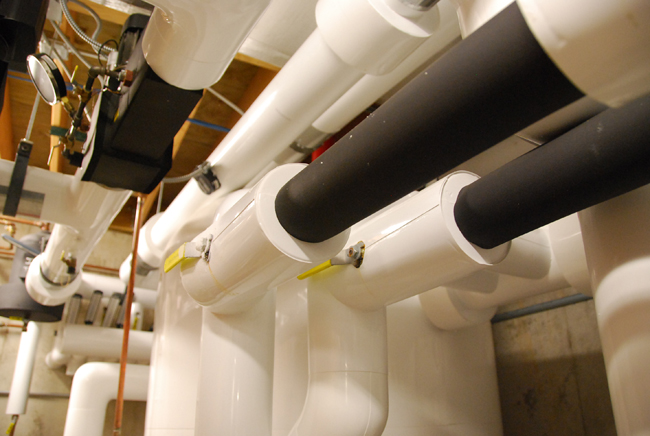
Pipe Insulation at the Aldo Leopold Legacy Center
This Carbon Neutral building uses full insulation on all of the piping leading from their solar hot water system, to the storage tank and back to the fixtures. The mechanical room is located in close proximity to the fixtures on the floor above.
FLAT PLATE COLLECTORS:
Flat plate collectors are the most commonly used. In a typical flat plate installation you should provide approximately one square metre of collector for every 45-50 litres of hot water to be stored.
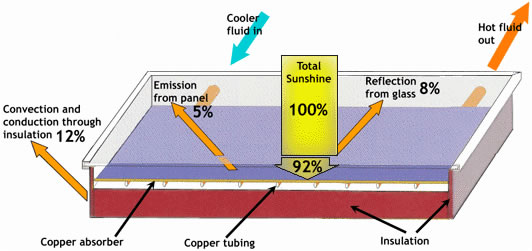
System Losses from a Typical Flat Plate Collector
Flat plate collector systems are normally roof mounted. The angle of inclination usually follows the rules for photovoltaic arrays as both will benefit when the angle of inclination of the sun to the surface of the array is closest to 90 degrees which will minimize reflectance.
VACUUM TUBE COLLECTORS:
The vacuum tube collector uses a series of glass tubes that act like thermos bottles. The glass allows the light through, which heats up the fluid inside the inner tube. The vacuum between the layers of glass prevents that heat from escaping back to the atmosphere on cold days.
On warm, sunny days, the performance of the vacuum collector is equal to that of the flat collector. But it will increasingly outperform the flat collector as the outside temperature decreases or light levels are reduced.
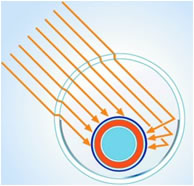 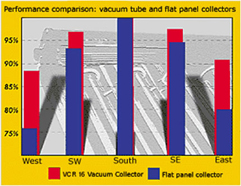
Vacuum Tube Section and Comparative Performance to Flat Plate Collectors
Because vacuum tube collector systems outperform flat plate collectors on east and west orientations, as their ability to collect radiation is less dependent on the incoming sun angle, these sytems might be recommended for use on projects where there is inadequate south facing potential for an installation, or where preference must be given to the true southern exposure for the benefit of the photovoltaic array.
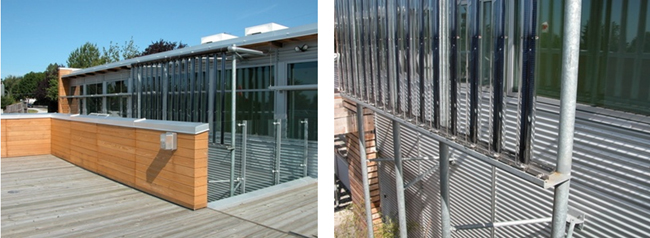
Evacuated Tube Installation at the White Rock Operations Center, Surry, B.C. LEED® Gold
Here they have used a vertical installation of tubes as they can take advantage of solar radiation coming in from all angles and do not necessarily have to be sloped to catch the sun's rays as is the case for photovoltaic arrays.
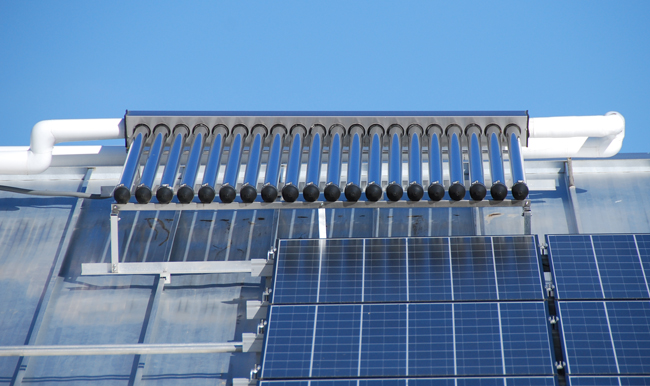
Aldo Leopold Legacy Center
Evacuated tubes towards the ridge of the roof with photovoltaics below. Note the substantial insulation wrap on the pipes leading into and out of the evacuated tube array.
CALCULATING YOUR REQUIREMENTS:
For domestic applications, this link will provide you with a method for calcuating your requirements. link For larger commercial installations, more in depth analysis will be required.

HELPFUL LINKS IN THE AIA 50to50 WIKI:
Active Solar Thermal Systems
|

